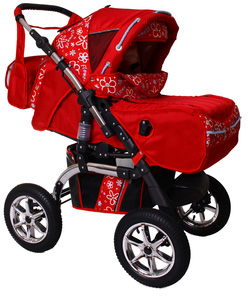Article at a Glance
This September 10, 2015, all strollers sold in the United States will be required to meet new mandatory standards that were approved back in March 2014.
The new standards address some of the most common stroller related injuries, including problems with hinges pinching, cutting, or severing fingertips. Other common concerns include wheels coming off, brake failures, fall and entrapment hazards, stability, and structural integrity.
For strollers bought before the mandatory guidelines come into effect, parents can look for the Juvenile Products Manufacturers Association (JPMA) sticker on the stroller’s frame. The new U.S. guidelines are more rigorous, but this lets parents know that their stroller at least meets the minimum, internationally accepted ASTM guidelines for safety.
If shopping for a new stroller, it is good to remember that you don’t need to spend a lot of money, but you will want to find a stroller that is safe. Although the new guidelines will help ensure stroller safety, it is still important to do your homework.
Right Size: Make sure your stroller is appropriate for your child’s size. You can usually find the stroller’s weight and height guidelines online or on the instructions that come with the stroller. If you are using a stroller with an attachment that allows another child to sit or stand, make sure your child meets the stroller’s weight guidelines.
Newborns: Until babies can hold up their heads on their own, they will need a stroller that reclines. Another option is to use an all-in-one travel system that allows you to attach the car seat to the stroller or a stroller frame. Make sure your car seat is designed to attach to your stroller and that the car seat can’t be easily knocked off.
If you use your car seat, make sure your baby doesn’t stay in the car seat for long periods of time. Using a car seat while driving provides important life-saving protection, but spending too much time in a car seat can create a flat spot on the back of your baby’s head and aggravate acid reflux. Sitting upright for a long time in a car seat can also compress your baby’s chest, leading to lower blood oxygen levels.
Breaks: Make sure your stroller has working breaks, preferably ones that lock down at least two wheels. Your child should not be able to reach the brake release lever from inside the stroller.
Stability: A stroller with a wide base and a seat that sits low in the frame is less likely to tip over. You can test the stroller by pressing lightly down on the handle to see if it tips.
Safety Harness: Look for a stroller that has a 5-point harness.
Entrapment Hazards: Look for any places where your baby’s hands or feet can get trapped or pinched. Pay particular attention to any hinges or spaces between footrests.
Recalls: Keep on top of any recalls by submitting the warranty card that comes with the stroller. If buying a used stroller, be sure to do a search for any recalls.
Easy to Maneuver: Look for a stroller that is easy to steer and maneuver. If you test it out in the store, remember that it will become harder to steer once there are children in it.
Reviews: Before making a final purchase, take a look at online reviews of the stroller you are thinking of buying. People who have used the stroller may have noticed safety concerns or quality issues that you hadn’t noticed.
No matter how safe your stroller is, it is no substitute for proper supervision. Don’t forget these safety tips when using your stroller.
